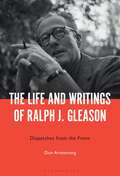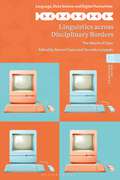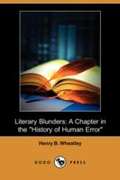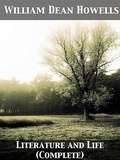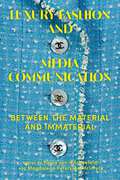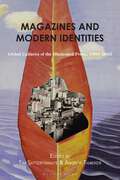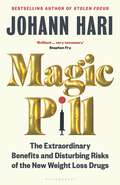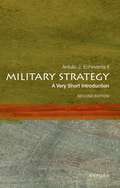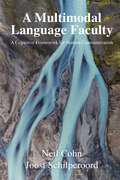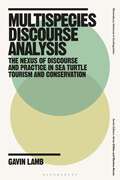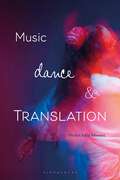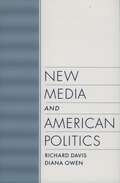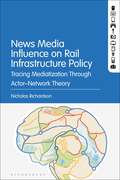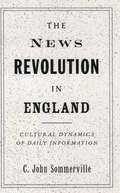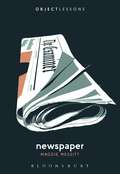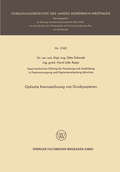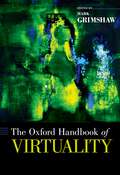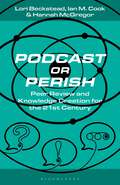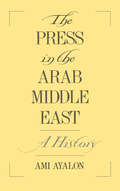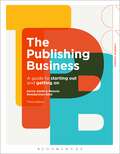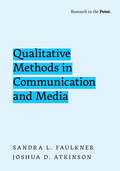- Table View
- List View
The Life and Writings of Ralph J. Gleason: Dispatches from the Front
by Professor. Don ArmstrongDiscover the enthralling world of Ralph J. Gleason, a pioneering music journalist who expanded the possibilities of the newspaper music column, sparked the San Francisco jazz and rock scenes, and co-founded Rolling Stone magazine. Gleason not only reported on but influenced the trajectory of popular music. He alone chronicled the unparalleled evolution of popular music from the 1930s into the 1970s, and while doing so, interviewed and befriended many trailblazers such as Miles Davis, Dizzy Gillespie, Bob Dylan, and the Beatles. A true iconoclast, he dismantled the barriers between popular and highbrow music, and barriers separating the musical genres. He played a crucial role in shaping postwar music criticism by covering all genres and analyzing music's social, political, and historical meanings. This book uncovers never-before-seen letters, anecdotes, family accounts, and exclusive interviews to reveal one of the most intriguing personalities of the 20th century.
Linguistics across Disciplinary Borders: The March of Data (Language, Data Science and Digital Humanities)
This volume highlights the ways in which recent developments in corpus linguistics and natural language processing can engage with topics across language studies, humanities and social science disciplines.New approaches have emerged in recent years that blur disciplinary boundaries, facilitated by factors such as the application of computational methods, access to large data sets, and the sharing of code, as well as continual advances in technologies related to data storage, retrieval, and processing. The “march of data” denotes an area at the border region of linguistics, humanities, and social science disciplines, but also the inevitable development of the underlying technologies that drive analysis in these subject areas.Organized into 3 sections, the chapters are connected by the underlying thread of linguistic corpora: how they can be created, how they can shed light on varieties or registers, and how their metadata can be utilized to better understand the internal structure of similar resources. While some chapters in the volume make use of well-established existing corpora, others analyze data from platforms such as YouTube, Twitter or Reddit. The volume provides insight into the diversity of methods, approaches, and corpora that inform our understanding of the “border regions” between the realms of data science, language/linguistics, and social or cultural studies.
Literary Blunders: A Chapter in the "History of Human Error"
by Henry B. WheatleyLinguist Wheatley discusses typographical errors, "Irish bulls," deliberate and accidental misquotations, poor translations from other languages into English and vice versa, and errors of fact in student papers and examinations.
Literary Copyright
by Charles Dudley WarnerThis is the first public meeting of the National Institute of Arts and Letters. The original members were selected by an invitation from the American Social Science Association, which acted under the power of its charter from the Congress of the United States. The members thus selected, who joined the Social Science Association, were given the alternative of organizing as an independent institute or as a branch of the Social Science Association.
Literature and Life (Complete)
by William Dean HowellsKnown as “The Dean of American Letters”, William Dean Howells (1837-1920) was a realist author and literary critic best known for his tenure as one of the most influential editors of the Atlantic Monthly, which is still an important publication today. And though Howells is known mostly for his work as a literary critic, he was also a novelist who wrote works like The Rise of Silas Lapham, Christmas Every Day, and much more. Along the way, he was a literary critic of the works of some of his greatest contemporaries, like Emile Zola, and he knew many American writers, including Mark Twain, Henry James, and Henry Wadsworth Longfellow.
Luxury Fashion and Media Communication: Between the Material and Immaterial
Using image and film advertisements, interviews, social media and public and private archives, Luxury Fashion and Media Communication offers an interdisciplinary approach to analyzing the value of the luxury object. Regular reports on consumption in media and frequent advertising on social media have allowed people all over the world to share in the issues and development of luxury; but how is it communicated, and how has it affected the consumer?An international range of scholars explore the material and immaterial value and meaning of luxury, how it is materialized and how it is communicated between the luxury industry and the consumer. Investigating French, Italian and Spanish luxury brands and their communication strategies on the global market, and including two chapters focusing specifically on the Chinese and American markets, they examine the ambiguity of the luxury commodity. This volume shows particularly the conflicting narratives between the idea of exclusivity and human skills and their mass marketing.In exploring theoretical perspectives alongside the practicalities of how luxury is communicated, Luxury Fashion and Media Communication reveals the value of the luxury object and the consumer's behaviour in relation to that value. It offers an innovative and important intervention in the inter-related fields of luxury fashion, media and communication, and key reading for scholars, students and practitioners wishing to explore the material and immaterial value of luxury.
Magazines and Modern Identities: Global Cultures of the Illustrated Press, 1880–1945
In the late nineteenth and early twentieth century, ideals of technological progress and mass consumerism shaped the print cultures of countries across the globe. Magazines in Europe, the USA, Latin America, and Asia inflected a shared internationalism and technological optimism. But there were equally powerful countervailing influences, of patriotic or insurgent nationalism, and of traditionalism, that promoted cultural differentiation. In their editorials, images, and advertisements magazines embodied the tensions between these domestic imperatives and the forces of global modernity.Magazines and Modern Identities explores how these tensions played out in the magazine cultures of ten different countries, describing how publications drew on, resisted, and informed the ideals and visual forms of global modernism. Chapters take in the magazines of Australia, Europe and North America, as well as China, The Soviet Turkic states, and Mexico. With contributions from leading international scholars, the book considers the pioneering developments in European and North American periodicals in the modernist period, whilst expanding the field of enquiry to take in the vibrant magazine cultures of east Asia and Latin America. The construction of these magazines' modern ideals was a complex, dialectical process: in dialogue with international modernism, but equally responsive to their local cultures, and the beliefs and expectations of their readers. Magazines and Modern Identities captures the diversity of these ideals, in periodicals that both embraced and criticised the globalised culture of the technological era.
Magic Pill: The Extraordinary Benefits and Disturbing Risks of the New Weight Loss Drugs
by Johann HariThe bestselling author of Lost Connections and Stolen Focus takes a revelatory look at the new drugs transforming weight loss as we know it – sharing his personal experience on Ozempic and examining our ability to heal society's dysfunctional relationship with food, weight and our bodies. In January 2023, Johann Hari started to inject himself once a week with Ozempic, one of the new drugs that produces significant weight loss. He wasn't alone – some predictions suggest that in a few years, one in four of the British population will be taking these drugs. While around 80 per cent of diets fail, someone taking one of the new drugs is likely to lose up to a quarter of their body weight in six months. To the drugs' defenders, this is a moment of liberation from a condition that massively increases your chances of diabetes, cancer and an early death. Still, Hari was wildly conflicted. Can these drugs really be as good as they sound? Are they a magic solution – or a magical illusion? Finding the answer to this high-stakes question led him on a journey from Iceland to Minneapolis to Tokyo, and to interview the leading experts in the world on these issues. He found that along with the drugs' massive benefits come twelve significant potential risks. He also learned that these drugs radically challenge what we think we know about shame, willpower and healing. These drugs are about to change our world, for better and for worse. Everybody needs to understand how they work – scientifically, emotionally and culturally. Magic Pill is an essential guide to the revolution that has already begun – and which one leading expert argues could be as transformative as the invention of the smartphone.
Military Strategy: Second Edition (Very Short Introductions)
by Antulio J. Echevarria IIDistilling the ideas of the greatest military theoreticians of history, including Sun Tzu, Niccol? Machiavelli, and Carl von Clausewitz, this clear and engaging Very Short Introduction presents a fascinating account of the "art of the general." Antulio J. Echevarria II highlights the dynamic relationship between the main elements of strategy: purpose, method, and means. Drawing on historical examples, he discusses the major types of military strategy and how emerging technologies are affecting them. This second edition has been updated throughout, and now includes an extended chapter on cyberwarfare which shows how the use of social media platforms to influence opinions on political views and manipulate populations to act in certain ways has evolved from an art to a science.
A Multimodal Language Faculty: A Cognitive Framework for Human Communication
by Dr Neil Cohn Joost SchilperoordNatural human communication is multimodal. We pair speech with gestures, and combine writing with pictures from online messaging to comics to advertising. This richness of human communication remains unaddressed in linguistic and cognitive theories which maintain traditional amodal assumptions about language. What is needed is a new, multimodal paradigm. This book posits a bold reorganization of the structures of language, and heralds a reconsideration of its guiding assumptions. Human expressive behaviors like speaking, signing, and drawing may seem distinct, but they decompose into similar cognitive building blocks which coalesce in emergent states from a singular multimodal communicative architecture. This cognitive model accounts for unimodal and multimodal expression across all of our modalities, providing a “grand unified theory” that incorporates insights from formal linguistics, cognitive semantics, metaphor theory, Peircean semiotics, sign language, gesture, visual language, psycholinguistics, and cognitive neuroscience. Such a perspective reconfigures how we understand linguistic structure, diversity, universals, innateness, relativity, and evolution. A Multimodal Language Faculty directly confronts centuries-old notions of language and offers a compelling reimagination of what language is and how it works.
Multispecies Discourse Analysis: The Nexus of Discourse and Practice in Sea Turtle Tourism and Conservation (Bloomsbury Advances in Ecolinguistics)
by Dr Gavin LambThis book explores how language and communication shape the increasingly entangled lives of people and sea turtles at the nexus of sea turtle conservation and ecotourism. Here, new ecocultural identities are taking shape as people strive to make sense of their shifting multispecies landscape, and as sea turtles gradually reclaim beaches after decades of absence. The book offers researchers in ecolinguistics and related ecologically engaged fields in discourse analysis an integrative theoretical and methodological approach to empirically investigate the human and 'more-than-human' discourses and practices shaping problematic human-wildlife interaction. Containing short vignettes in each chapter covering the biology and behaviours of sea turtles, this book suggests how discourse analysts might contribute to a 'life-sustaining multispecies ethics' in an uncertain socio-ecological time increasingly being referred to as the Anthropocene.
Music, Dance and Translation
How is music affected by its translation, interpretation and adaptation with, through, and by dance? How might notation of dance and music act as a form of translation? How does music influence the creation of dance? How might dance and music be understood to exchange and transfer their content, sense and process during both the creative process and the interpretative process? Bringing together chapters that explore theory and practice, this book questions the process and role translation has to play in the context of music and dance. It provides a range of case studies across this interdisciplinary field, and is not restricted by genre, style or cultural location. As one of very few volumes to explore translation in relation to music and to overtly tackle this topic in terms of dance, it moves the argument from a broad notion of text and translation, to think critically about the sound and movement arts of music and dance, using translation as a model to better understand the collaboration of these art forms.
New Media And American Politics
by Richard Davis Diana OwenNew Media and American Politicsis the first book to examine the effect on modern politics of the new media, which include talk radio, tabloid journalism, television talk shows, entertainment media, and computer networks. Davis and Owen discuss the new media's cultural environment, audience, and content, before going on to evaluate its impact on everything from elections to policy making to the old media itself.
News Media Influence on Rail Infrastructure Policy: Tracing Mediatization Through Actor–Network Theory
by Nicholas RichardsonIn this book, Richardson's research spans a decade and two cities - Sydney, Australia and Montreal, Canada - focusing on three metro-style rail infrastructure case study projects: one ongoing, one failed and one upgraded after reaching fifty years of age – to build an irrefutable case that the news media is highly influential to policy, and that these influences are complex, messy and changing.News Media Influence on Rail Infrastructure Policy offers scholars and industry practitioners in the arenas of policy analysis, politics and media communications a method for astutely guiding large-scale projects through the complex and changing landscape of 24/7 news media. It is underpinned by empirical research that identifies and endeavors to close a considerable gap in current understanding and practice. This gap represents a failure to recognise and respect mediatization – the many powerful influences impacting a policy arena that has drawn the ire of the news media. The result of this failure is ineffective communication that does little to advance the policy piece and, in the worst instances, leads to policy immobilisation or poor policy decision-making.Drawing significantly on Actor–Network Theory, Richardson identifies the influential actors and alliances at play when policy is subjected to media discourse, and he proposes a framework for tracing and managing them. In doing so, he demonstrates that such a framework is not only vital for the successful negotiation of policy and projects in the media, but also to an (r)evolutionary recasting of public, expert and media actors in the development and decision-making process.
Newspaper (Object Lessons)
by Dr. Maggie MessittObject Lessons is a series of short, beautifully designed books about the hidden lives of ordinary things.Newspaper is about more than news printed on paper. It brings us inside our best and worst selves, from censorship and the intentional destruction of historic record, to partisan and white supremacist campaigns, to the story of an instrument that has been central to democracy and to holding the powerful to account. This is a 400-year history of a nearly-endangered object as seen by journalist Maggie Messitt in the two democratic nations she calls home – the United States and South Africa.The “first draft of history,” newspapers figure prominently through each movement and period of unrest in both nations-from the first colonial papers published by slave traders and an advocate for press freedom to those published on id cards, wallpaper, and folio sheets during civil wars. Offices were set on fire. Presses were pushed into bodies of water. Editors were run out of town. And journalists were arrested.Newspaper reflects on a tool that has been used to push down and to rise up, and a journey alongside the hidden lives that have harnessed its power.Object Lessons is published in partnership with an essay series in The Atlantic.
Optische Kennzeichnung von Druckpapieren (Forschungsberichte des Landes Nordrhein-Westfalen)
by Otto SchwabPodcast or Perish: Peer Review and Knowledge Creation for the 21st Century (Bloomsbury Podcast Studies)
by Lori Beckstead Ian M. Cook Hannah McGregorPodcasting scholarship is still in its nascent stages. The use of podcasting as a tool for scholarly and intellectual inquiry is a relatively new idea, to think about the medium as an alternative outlet for research output. Podcast or Perish maps out not simply a rationale for the deployment of podcasting as an outlet for open peer review, but also explores some real-world workflows for such a practice.At the forefront of merging these exciting fields, Lori Beckstead, Ian M. Cook, and Hannah McGregor have taken a novel approach to expanding the boundaries of scholarly knowledge by considering podcasting as a focal point for intellectual discussion, engagement, and exploration. By investigating the historical development of the norms of scholarly communication, the unique affordances of sound-based scholarship, and the transformative potential of new modes of knowledge production, Podcast or Perish is the call to action academia needs, by asking how podcasting might change the very ways we think about scholarly work.
The Publishing Business: A Guide to Starting Out and Getting On (Creative Careers)
by Kelvin Smith Dr Melanie Ramdarshan BoldAre you considering a career in the world of publishing, or simply want to understand more about the industry? If so, The Publishing Business will take you through the essential publishing activities performed in editorial, rights, design, production, sales and marketing departments. International examples from across the industry, from children's books to academic monographs, demonstrate key responsibilities at each stage of the publishing process and how the industry is adapting to digital culture. This 3rd edition has been updated with more on the role of self-publishing, independent publishers, audio books, the rise of poetry and non-fiction and how the industry is facing up to challenges of sustainability, inclusivity and diversity.Beautifully designed and full of insight and advice from practitioner interviews, this is an essential introduction to a dynamic industry. Interviewees include:Anne Meadows, Commissioning Editor at Granta and Portobello BooksZaahida Nabagereka, Head of Social Impact at Penguin Books UK Ashleigh Gardner, Senior Vice President, Managing Director Global Publishing, WattpadCaroline Walsh, Literary Agent, David Higham AssociatesPeter Blackstock, VP, Deputy Publisher, Grove Atlantic/Publisher, Grove Press UKAmy Ellis, Head of Rights and Permissions, Publishers' Licensing ServicesVictoria Lawrance, Rights Manager, Bloomsbury Publishing PlcShaun Hodgkinson, COO, Dorling KindersleyThomas Truong, Publishing Director, Little Tiger GroupJenny Blenk, Associate Editor, Dark Horse Comics Jeanette Morton, Digital Publisher, Oxford University PressMaria Vassilopoulos, Publishing Sales, Uni of Wales Press and Calon BooksIan Lamb, Head Of Children's Marketing and Publicity, Simon and Schuster
Qualitative Methods in Communication and Media (Research to the Point)
by Sandra L. Faulkner Joshua D. AtkinsonQualitative Methods in Media and Communication offers a learning-centered guide to designing, conducting, and evaluating qualitative communication and media research methods. Drawing upon years of teaching qualitative research methods, Sandra L. Faulkner and Joshua D. Atkinson introduce and unpack qualitative communication research method design, analysis, representation, writing, and evaluation using extended examples and clear discussion. The authors use key terms, extended examples, discussion questions, student-tested writing and research activities, examples of student work and questions, and suggested resources to help readers design, do, and analyze qualitative research. As a textbook, its pedagogical goals for the student include: (1) becoming a critical reader of research studies by understanding the epistemologies and methodological assumptions used by researchers, (2) learning the various methods, strategies, and approaches for doing qualitative research, (3) developing a strong basic vocabulary and understanding of concepts relating to qualitative and humanistic research methods, (4) understanding special concerns related to particular research methods, and (5) designing, executing, and representing original qualitative research projects. With numerous elements intended to engage students and enrich the learning process, the book provides examples of how to do qualitative and critical analyses, including arts-based and media and textual analyses to understand, describe, and query communication and media research in a variety of communication areas. There is also an extensive discussion of ethics in qualitative research and spotlights with renowned researchers on hot topics in qualitative research.
Rediscovering Rubén Darío through Translation
by Dr. Carlos F. GrigsbyA long overdue examination of Rubén Darío's multilingual work and influences alongside the contexts and politics of canonization in world literature. Rediscovering Rubén Darío through Translation addresses the peculiar obscurity of Darío by asking these questions: How can one of the most important writers of a major world language be almost entirely unknown in the English-speaking world? How is it that other writers of the same language (e.g., Lorca or García Márquez) achieve widespread recognition in the anglophone world, while he remains unnoticed? What role does translation play in this? What can it tell us about the way in which world literature is articulated? Carlos F. Grigsby approaches Darío's oeuvre through translation. In doing so, he explores not only the place of Darío in the translation of Spanish American literature into English, but also the place of translation in Darío's own writing. The result is a double-sided painting, as it were: the recto is titled “Translation in Darío” and the verso “Darío in Translation.” This book challenges the field of world literature by revealing some of the biases present in its representation of Spanish American literature. It adopts a multilingual framework – chiefly using English, Spanish, French, and to a lesser degree Latin and Catalan – in analyzing Darío's writing alongside that of his contemporaries. As a result, it reveals the multilingualism of Darío's own writing, opening new avenues for the study of his work and of Spanish American modernismo more generally.
Repression in the Digital Age: Surveillance, Censorship, and the Dynamics of State Violence (Disruptive Technology and International Security)
by Anita R. GohdesGlobal adoption of the Internet has exploded, yet we are only beginning to understand the Internet's profound political consequences. Authoritarian states are digitally catching up with their democratic counterparts, and both are showing a growing interest in the use of cyber controls--online censorship and surveillance technologies--that allow governments to exercise control over the Internet. Under what conditions does a digitally connected society actually help states target their enemies? Why do repressive governments sometimes shut down the Internet when faced with uprisings? And how have cyber controls become a dependable tool in the weapons arsenal that states use in civil conflict? In Repression in the Digital Age, Anita R. Gohdes addresses these questions, and provides an original and in-depth look into the relationship between digital technologies and state violence. Drawing on large-scale analyses of fine-grained data on the Syrian conflict, qualitative case evidence from Iran, and the first global comparative analysis on Internet outages and state repression, Gohdes makes the case that digital infrastructure supports security forces in their use of violent state repression. More specifically, she argues that mass access to the Internet presents governments who fear for their political survival with a set of response options. When faced with a political threat, they can either temporarily restrict or block online public access or they can expand mass access to online information and monitor it to their own advantage. Surveillance allows security forces to target opponents of the state more selectively, while extreme forms of censorship or shutdowns of the Internet occur in conjunction with larger and more indiscriminate repression. As digital communication has become a bedrock of modern opposition and protest movements, Repression in the Digital Age breaks new ground in examining state repression in the information age.
